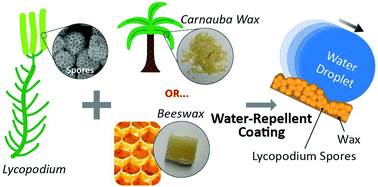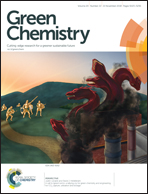A methodology to produce eco-friendly superhydrophobic coatings produced from all-water-processed plant-based filler materials†
Abstract
Rising environmental concerns have forced many industries to seek more environmentally-friendly processing methods and safer material alternatives. The development of water-repellent (superhydrophobic and low-adhesion) coatings is one such application. Typically, repellent coatings make use of low surface energy materials (often fluorinated, or containing organosilicon compounds) that require processing with harsh organic solvents. We report a methodology to fabricate fluorine- and silane-free, entirely water-based coating formulations with plant-based filler materials (e.g. cellulose, lycopodium) for making superhydrophobic surfaces, commonly defined as having water contact angles greater than 150°. All of the formulations discussed herein contain a plant-based filler material that imparts surface roughness, and an aqueous, polymeric dispersion providing the low surface energy coating component. More importantly, the present formulations are developed using a facile, low-cost, safe processing technique. Out of several coating formulations developed in this work, those comprising of lycopodium and a natural wax (e.g. carnauba wax, beeswax) offer the highest performance in terms of hydrophobicity and water mobility, with the added advantages of no nanoparticles and thermal processing at temperatures below 100 °C. Once applied to a substrate, these coatings comprise of ∼99.5% naturally-occurring materials, with the remaining 0.5% comprising an FDA approved cross-polymer (Pemulen 1622). The green approach presented in the current study opens new avenues for technological advancement in water-repellent coatings without adverse environmental consequences.



 Please wait while we load your content...
Please wait while we load your content...